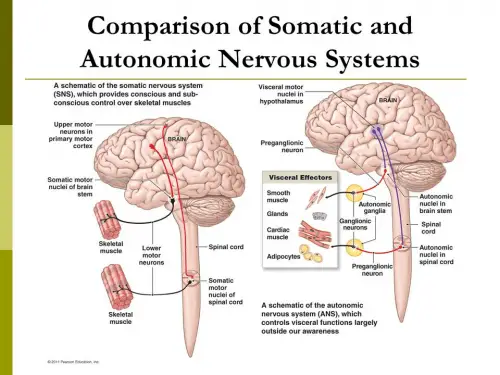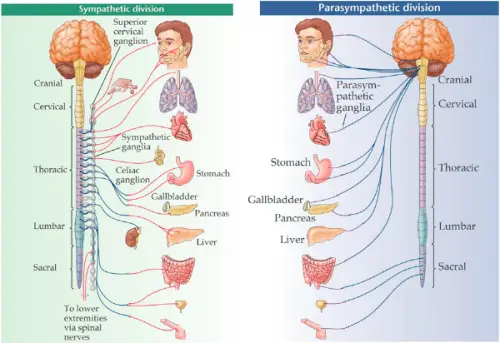The peripheral nervous system is made up of two essential parts: the somatic and the autonomic nervous systems. However, despite their strong relationship, there are a lot of differences between the two.
Summary Table
| Somatic Nervous System | Autonomic Nervous System |
| Regulates the voluntary movement of the body | Regulates the involuntary movement of the body |
| Regulates movements of the body via the skeletal muscles, along with sensory stimuli related to vision, smell, taste, pain, noise, touch, and temperature | Regulates bodily functions such as respiratory rate, heart rate, urination, digestion, sexual arousal, pupillary response, and digestion |
| Made up of the afferent nerves (sensory nerves) and efferent nerves (motor nerves) that stimulate skeletal muscle movement | Made up of a complex network of motor neurons, which control glands, cardiac muscles, and smooth muscles |
| Divisions include the spinal nerves and the cranial nerves | Divisions include the sympathetic and the parasympathetic nervous system |
| One neuron acts as a link between the central nervous system and the effector cells | Two neurons act as a link between the central nervous system and the effector cells |
| Releases acetylcholine to the effector cells | Releases acetylcholine and norepinephrine to the effector cells |
Definitions

The somatic nervous system (SoNS) is a division of the peripheral nervous system (PNS). Popularly known as the voluntary nervous system, the SoNS is comprised of sensory nerves and motor nerves that are responsible for the voluntary movement of the body.

The autonomic nervous system (ANS) is the part of the peripheral nervous system that is responsible for the body’s involuntary movements, including digestion, heart rate, sexual arousal, and pupillary response.
Somatic vs Autonomic Nervous System
Despite playing equally important roles for the normal functioning of the peripheral nervous system, there is a huge difference between the somatic and the autonomic nervous system.
Regulation
Both the somatic and the autonomic nervous systems are essential divisions of the peripheral nervous system. While the former regulates the voluntary movement of the body, the latter is responsible for controlling the body’s involuntary movements, which are also called visceral functions.
Control
A control system that greatly influences the operation of internal organs, the ANS monitors and regulates bodily functions such as respiratory rate, heart rate, urination, digestion, sexual arousal, pupillary response, and digestion.
The SoNS does not affect the body’s internal organs.
Instead, it controls movements of the body via the skeletal muscles. It detects and relays sensory stimuli related to vision, smell, taste, pain, noise, touch, and temperature.
Composition
The SoNS is comprised of afferent nerves (sensory nerves) and efferent nerves (motor nerves) that stimulate skeletal muscle movement. The ANS, by contrast, consists of a complex network of motor neurons, which control glands, cardiac muscles, and smooth muscles.
Divisions
The SoNs has two major divisions: the spinal nerves and the cranial nerves. The spinal nerves relay sensory, autonomic, and motor signals from the brain to the body, while the cranial nerves convey sensory information to and from the brain stem.
The ANS, on the other hand, is made up of the sympathetic and the parasympathetic nervous system.
The sympathetic nervous system, also known as the “fight or flight” response, prepares the body for situations that trigger fear, excitement, alertness, or intense emotions.
The parasympathetic nervous system, on the contrary, is active during rest, relaxation, and digestion.
Number of Neurons
In the ANS, the preganglionic and postganglionic neurons act as a link between the central nervous system and the effector cells, which prompts the body to act in response to a stimulus. Comparatively, in the SoNS, only a single neuron connects the central nervous system and the skeletal muscles.
Neurotransmitter
Lastly, the SoNS releases acetylcholine, a chemical that sends signals in between cells, to the effector cells. Meanwhile, the ANS transmits norepinephrine and acetylcholine to the effector. Norepinephrine is a chemical released by the body in response to stress.





